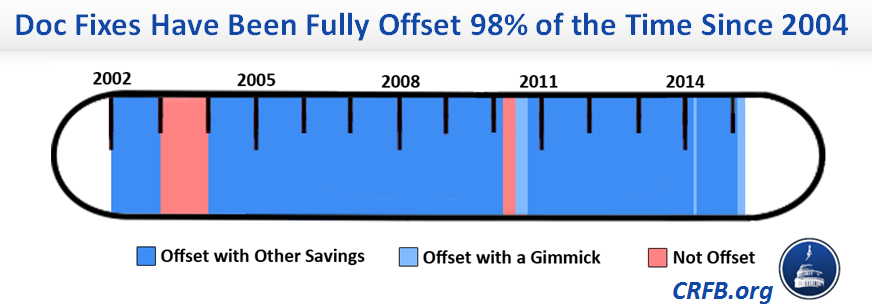SGR Continues to Slow Health Care Cost Growth
The Senate voted 64-35 today to approve a 12-month temporary “doc fix” to push back the impending nearly 25 percent cut to Medicare physician payments dictated by the Sustainable Growth Rate (SGR) formula.
After the bipartisan, bicameral agreement on how to replace the SGR, hopes were elevated that lawmakers could acheive a permanent fix. Once again, though, a permanent replacement proved elusive due to disagreements over how, or even whether, to pay for the $180 billion cost of providing payment updates and making permanent a host of temporary programs.
While a full replacement would have been ideal, this temporary patch continues the SGR’s tradition of prompting serious, if small, health care reforms (although one-fifth of the bill is offset through a timing gimmick).
The largest savings in the bill, from allowing the Department of Health and Human Services (HHS) to collect and use data on values of physician services to more accurately set Medicare payments, is a variant of a direct recommendation from MedPAC the last two years.
Reducing Medicare lab test payments to bring them in line with those from private payors jumps right off a recent study and recommendations from HHS’ Office of Inspector General (OIG). And basing payment rates for skilled nursing facilities (SNFs) in part on measures of avoidable readmissions has been recommended by MedPAC and been included in President Obama’s last three budgets.
| CBO Estimate of One-Year Doc Fix Bill (billions of dollars) | |
| Policy | 2014-2024 Savings/Costs (-) |
| Spending Increases | -$20.9 |
| Extend doc fix for one year | -$15.8 |
| Extend health extenders and certain other provisions for one year | -$4 |
| Create demonstration program for community mental health services | -$1.1 |
| Offsets | $17.2 |
| Re-arrange Medicaid DSH payments and extend ACA reduction through 2024 | $4.4 |
| Revise payments for over-valued physician services | $4.0 |
| Set clinical lab payments equal to private payor rates | $2.5 |
| Eliminate SGR transition fund | $2.3 |
| Implement value-based purchasing program for SNFs | $2.0 |
| Update prospective payment system for end-stage renal disease | $1.8 |
| Other provisions | $0.2 |
| Subtotal, Excluding Gimmicks | -$3.7 |
| Shift Medicare sequester in FY2025 into FY 2024 | $4.9 |
| Total | $1.2 |
Source: CBO
In total, now, lawmakers have offset 132 out of 135 months of doc fixes since 2004 with equivalent savings, or 98 percent of the time. Even disregarding the few times small gimmicks were used, policymakers still paid for these delays 94 percent of the time – with almost all of those savings coming from health care programs.
Although the SGR clearly has not functioned as intended, it has served as an action forcing mechanism to prompt targeted health reforms in place of its prescribed blunt, across-the-board cuts. Once the president signs this patch into law, the need to offset the costs of repeated doc fixes will have resulted in $165 billion of deficit reduction from 2003 through 2025.
Although replacing the SGR altogether would offer an opportunity to pursue more structural Medicare reforms instead of tinkering on the margins, the one-year patch in this bill illustrates that continuing to paying for temporary patches can also have positive effects. Without the annual SGR exercise, many of these MedPac recommendations and proposals from the President's Budget may not have ever been enacted.
Methodology Notes: To calculate the cumulative savings resulting from policies enacted to offset delays to the Medicare Sustainable Growth Rate (SGR) formula ($140 in total from 2003-2024), we analyzed Congressional Budget Office (CBO) scores of the relevant legislation. We allocated savings to costs based both on the score and our understanding of legislative history. For instance, although the American Taxpayer Relief Act of 2012 increased the debt in total, lawmakers explicitly designated requisite health care savings to offset the costs of the "doc fix" included. In the multiple cases where deficit-reducing reforms were intended to offset both an SGR delay and a temporary extension of the various so-called "health extenders," we only counted the percentage of savings necessary to offset the SGR delay, and ignored the additional savings for the purposes of this analysis. The analysis does not incorporate the effects of doc fixes on federal interest costs. To estimate deficit savings beyond the 10-year windows estimated by CBO, we analyzed each policy separately, but for most we assumed that annual savings continued as the same percentage of their respective baseline. The estimates in this blog do not include either the savings achieved by the SGR reduction when it took effect in 2002 or the extrapolated costs of the deficit-financed SGR delay in 2003, due to a lack of data. Additionally, this analysis does not account for potential behavioral effects beyond those incorporated in CBO estimates that lower Medicare physician payment rates may have had in increasing the volume of physician services.




